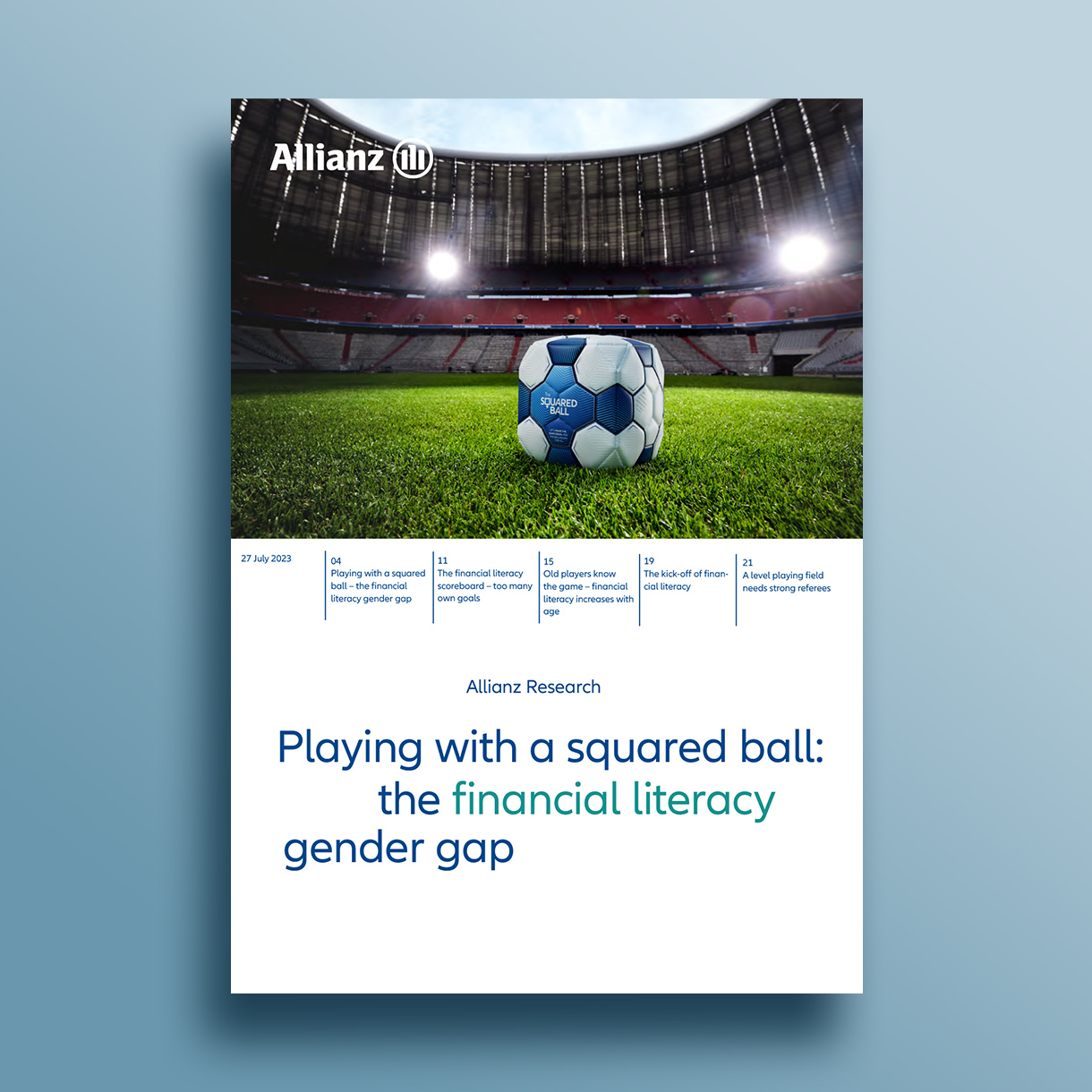Financial assets: annus horribilis
In any case, it was an annus horribilis for savers. After years of the "everything rally", asset prices fell across the board last year. In the US, for example, stock prices fell by more than -18%, while the corresponding bond indices suffered setbacks of more than -10%. In most other countries, the development looked similar as the turnaround in interest rates was more or less conducted by all countries – albeit at different speeds. As a result, the old rules of diversification no longer applied in 2022; in the "everything slump" scenario, there was no protection for the portfolio.
This environment left deep scars in the development of private households’ global financial assets, which declined by -2.7% in 2022, the strongest decline since the Global Financial Crisis (GFC) in 2008. Overall, financial assets worth EUR6.6trn were lost, with total financial assets amounting to EUR233trn at the end of 2022 (Figure 1). Relative to economic activity (financial assets as a percentage of GDP), the collapse was even more dramatic: This ratio fell to 275%, after 311% in 2021, which was even lower than the value from 2016 (277%); even during the GFC, this decline was "only" a good 30pps. However, GDP, which was inflated by high inflation, also played a major role here.

Figure 1: Everything slump
Figure 2: Stable bank deposits
The world saves differently
It is also noticeable that the long-term growth rates of the asset classes over the last two decades do not differ greatly from each other: Securities achieved +7.0% annual growth on average, bank deposits +6.4% and insurance/pensions +5.2% over the long term; for total financial assets this rate is +6.2%. The global portfolio shifts are therefore correspondingly moderate, with the development of securities and insurance/pensions almost mirroring each other. While the former increased by almost 6pps to 41% of total financial assets, the latter lost almost 6pps (27%); bank deposits, on the other hand, held up well (+1pp to 30%). The remaining financial assets of less than 3% are allotted to the category "other".
However, the differences between the regions are striking (Figure 3). Insurance/pensions, for example, hardly play a role in Eastern Europe but are the dominant asset class in Western Europe (as well as in Australia). The same can be said about bank deposits: while they play only a minor role in the Americas, they are the most popular savings vehicle in Eastern Europe and Asia – with the exception of China, where so-called wealth-management products are very popular. Americans, on the other hand, rely mainly on securities, especially stocks and mutual funds.
Figure 3: A colorful world of saving preferences
Besides asset prices, savings also declined significantly in 2022 – which has already been indicated by the "normalization" of bank-deposit growth. They fell by -24% last year to EUR3.8trn. However, after the two years of forced savings during the Covid-19 pandemic, this decline is no surprise: With the economy reopening, 2022 was all about (catch-up) consumption. However, it would be an exaggeration to speak of a consumption rush as fresh savings are still above the 2019 pre-pandemic level (EUR3.6trn).
More remarkable than the decline in savings is therefore the change in the composition of funds (Figures 4 and 5). Of the three major asset classes, only one suffered significant setbacks: bank deposits. Here the global decline was -79%, mainly because American savers withdrew funds from banks again. But at EUR13.9trn, the stock of bank deposits is still significantly higher than before the pandemic (2019: EUR10.4trn). In other regions, bank deposits were not liquidated but new allocations fell sharply, for example by -26% in Western Europe and by -35% in Japan. In contrast, twice as many securities were purchased globally as in 2021. Once again, US households were the driving force: their securities purchases tripled. This reflects a rather anti-cyclical savings behavior: many American savers seem to have seen the setbacks on the stock markets as an entry opportunity. Other savers, however, were much more cautious. In Western Europe, securities purchases fell by a good third, though they remained at an extremely high level by European standards at over EUR200bn – before the pandemic, European savers generally found themselves on the sell side. This development also differs fundamentally from the GFC: In 2008, there was a sell-off of securities worldwide as the panic on the markets was much stronger. With regard to insurance/pensions, as in previous years, the development is less spectacular. In line with the character of a long-term savings vehicle for old-age provision, the swings in fresh savings were smaller than in the other two securities classes. Nevertheless, the inflow of fresh funds rose by +17% in 2022. Here again it is primarily US savers who used the opportunity of increased savings from the pandemic years to top up their retirement provisions.
Figure 4: Still elevated
Figure 5: Anti-cyclical savings behavior
Financial literacy pays
Does financial literacy actually make a difference when it comes to investment results? In June 2023, we ran a survey testing the financial skills of participants in five countries and also asked them about their assessment of various asset classes in the current investment environment . This allowed us to construct an ideal portfolio depending on the level of financial literacy. What is striking here is that those participants with low financial literacy most often choose cash as an investment. Moreover, with a share of 38%, the group of undecideds – who ultimately leave their money untouched in their current accounts – is also by far the largest among them (average financial literacy: 15%; high financial literacy: 7%). Both together lead to a strong overweighting of cash: compared to the portfolios of participants with average financial literacy, the share of cash is 67% higher; at the same time, equities and investment funds are underweighted by around 30%.
In the next step, we adjusted these three ideal typical portfolios to the prevailing structures in the respective market because our participants do not make decisions in a “free” investment environment but are subject to the conditions and institutions of their country. This implies, for example, a high share of pension funds in Australia due to the popularity of “superannuation” there, or a high share of equities in the US due to the widespread use of 401k plans.
In the final step, we calculate the average real annual return of these portfolios by taking the respective actual performance of the stock and bond markets over the last 20 years. Figure 6 summarizes the results.


Figure 6: Playing the game
Three observations stand out. First, returns increase with the level of financial literacy. This is by no means self-evident. For the period observed also includes the years 2008 and 2022, in which equity investors (2008) and bond investors (2022) lost a lot of ground. These were disastrous years for the “pros”, when the default option “cash” proved to be the far better alternative.
Second, the difference in returns between average financial literacy and high financial literacy is small. The portfolios of these two investor types are already largely similar. This is true for all markets in our survey. On the other hand, the difference in annual average returns between low and average financial literacy is considerably higher, ranging from 1.2pp in France to 1.5pp in Spain. Only the US is an exception here, with an annual difference in returns of 0.8pp. One possible explanation is the relatively high share of equities even among the low-financial-literacy investor type due to the institutional framework. Together with the extraordinary development of the US equity markets – an increase by a factor of 6.5 since 2002 – this leads to a certain levelling of returns.
Third, returns in Anglo-Saxon markets are higher. There are two reasons for this: first, the institutional framework that ensures the widespread use of funded pension schemes. As a result, many investors – directly or indirectly – have a high proportion of equities and other high-yielding assets in their portfolios. In addition, there is the strong development of the stock markets themselves – which of course should not be seen in isolation from the institutional framework. Besides the US, Australia also stands out here, with a market that more than quintupled. Only the UK is somewhat out of line with the trend for Anglo-Saxon markets: Although its stock market development is also quite respectable – an increase by a factor of 4 since 2002 – it nevertheless lags slightly behind France (4.1) and Germany (4.8); the reasons are probably to be found in home-made problems (cue Brexit). Bringing up the rear in this analysis are Italy (2.1) and Spain (3.2), which suffered particularly from the euro crisis. It is quite telling that, despite the big difference in market performances, returns in Germany and Spain are overall pretty much the same, testament to the generally rather cautious investment behavior of German households, with their penchant for liquidity, i.e. cash and bank deposits.
How do these differences in returns translate into euros? Table 1 provides an overview based on the amount of financial assets owned by the average household in the respective country (and under the simplified assumption of a uniform average household size of two persons in all countries).
Swipe to view more
|
|
Australia |
France |
Germany |
Italy |
Spain |
UK |
US |
|
Average financial literacy |
4,690 |
2,390 |
2,300 |
2,150 |
1,750 |
3,210 |
4,740 |
|
High financial literacy |
5,000 |
2,730 |
2,690 |
2,300 |
1,910 |
3,690 |
4,870 |
These figures need no further explanation – they speak for themselves: Over long investment periods – as is common in old-age provision – financial illiteracy costs a fortune, literally.
Note that in the US, the excess return is the highest even though the yield difference is the smallest. This is solely due to the fact that average financial assets in the US are more than twice as large as in the other markets studied.
The Chinese years

Figure 7: Sometimes it hurts instead
Sources: Eurostat, national central banks, financial supervisory authorities, financial associations and statistical offices, IMF, Refinitiv Eikon, Allianz Research.
Figure 8: Big in China
Inflation eats up excess savings
The wedge that inflation drives between the nominal growth of financial assets and the preservation of purchasing power has been huge not only in the long run but of course also in 2022, when the global inflation rate climbed above 8%. Last year, financial assets worldwide lost well over -10% in value. While household financial assets worldwide were still nearly 19% above pre-Covid-19 levels – in nominal terms – at the end of last year, they were only 6.6% above when adjusted for inflation. That means almost two-thirds of (nominal) wealth growth fell victim to price increases (Figure 9). However, thanks to comparatively low increases in consumer prices (on average +2.4% per year), households in Asia suffered significantly lower inflation-induced losses than savers in the rest of the world. With a real plus of +19.7% over 2019, they were in the lead by a clear margin. Eastern Europe and Latin America followed, with a real asset growth of almost +12% and nearly +10%, respectively. But the inflation-related losses were painful: As consumer prices increased by a staggering +11.3% and +9.8% per year on average, more than 70% of the nominal rise was lost in both regions. In North America, as well as in Australia and New Zealand, the average annual inflation rate of 4.6% and 3.5%, respectively, was well above the target of 2% and cost savers an even greater share of their wealth growth than in the two emerging regions mentioned above. In Australia and New Zealand, inflation ate up 78% of asset growth, while North America lost more than 80%.
However, Western Europe took the lead for the world's highest inflation losses. Average annual inflation amounted to 3.7%, not only reducing but erasing any gains in financial wealth: real wealth decreased by -2.6% over 2019. In absolute terms, this translates into an asset loss of EUR1.1trn compared to 2019, which corresponds to a decline in private savings of EUR2,930 per capita on average. In nominal terms, however, the total increase since then amounted to an impressive EUR3.3trn, or the equivalent of EUR7,310 per capita. In other words, inflation wiped out pandemic-related gains; excess savings in Western Europe now only exist on paper.
Figure 9: Inflation bites
The undisputed hegemon (in finance)






